In-Depth Look at Hinges for Bifold Doors
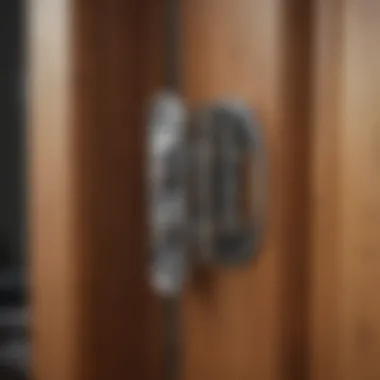
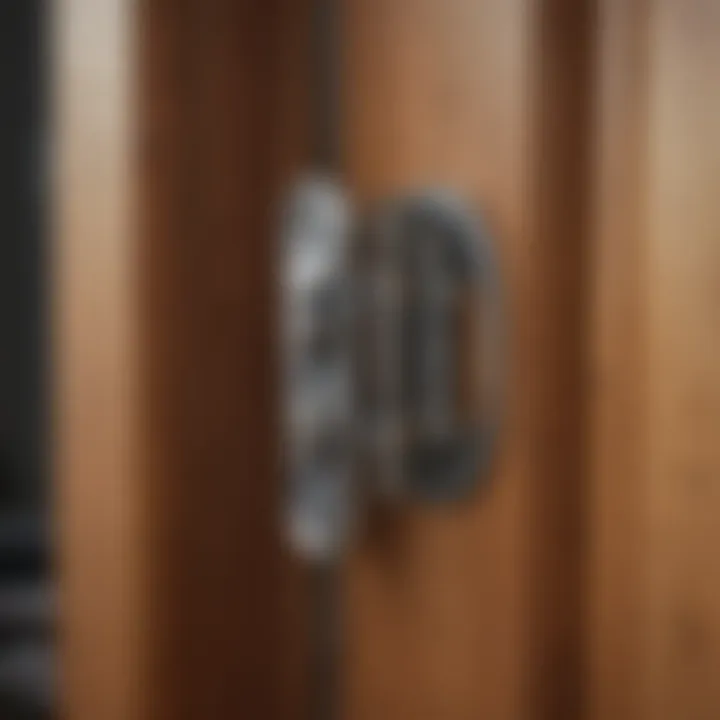
Intro
Bifold doors have gained popularity in both residential and commercial settings. They can seamlessly connect indoor and outdoor spaces while effectively enhancing the aesthetic appeal of a property. However, a key, yet often overlooked, component that contributes to their functionality is the hinge. Hinges serve as the backbone of bifold doors, allowing them to fold and unfold gracefully. Understanding the mechanisms behind these hinges is crucial for homeowners looking to make informed decisions regarding installation and maintenance.
Importance of the Topic
The hinges used in bifold doors may seem trivial at first glance, but they play a vital role in ensuring the doors operate smoothly. A well-designed hinge can extend the lifespan of the doors, improve their usability, and reduce the likelihood of malfunction. For those considering a home improvement project, it’s important to recognize that poor hinge selection or installation can lead to bending, sagging, or even complete failure. As a result, a thorough comprehension of the various hinge types and their specific applications can optimize door functionality, ultimately enhancing your living space.
"Knowledge is power, especially when it comes to home improvement. Better hinge choices mean better bifold doors."
In this context, we will navigate through common challenges faced by homeowners when it comes to bifold door hinges, explore effective solutions, recommend industry-leading products, and provide a detailed step-by-step guide for installation. Whether you are a seasoned builder or a design enthusiast, understanding these components will empower you to create a more efficient and elegant bifold door setup.
Prelims to Bifold Doors
Bifold doors have become a favorite choice for many homeowners and builders alike due to their unique blend of functionality and aesthetic appeal. These doors open up an entire space, merging indoor and outdoor environments seamlessly. They're particularly suitable for areas like patios, balconies, and even closets. Their folding mechanism not only saves space but can also provide a grand entrance in any setting.
When considering bifold doors, one must appreciate the value they add. For instance, they allow natural light to flood a room, creating an open and inviting atmosphere. This not only enhances the feel of a home, making it feel larger and brighter, but can also aid energy efficiency. Well-placed bifold doors can significantly cut down on your electricity bill by maximizing sunlight.
One noteworthy aspect is the versatility of bifold doors. They can be made from various materials, including wood, aluminum, and vinyl, catering to different tastes and budgets. The variety allows homeowners to choose a style that complements their existing décor. Plus, they can be customized to fit various widths and configurations, making them suitable for both expansive spaces and more intimate areas.
Considerations should also be given to installation and maintenance practices. Regular checks and timely maintenance of bifold doors can prevent minor issues from snowballing into costly repairs. Homeowners should look out for the hinges, tracks, and seals which are crucial for the performance of these doors. After all, a door isn't just a barrier; it’s an entryway that shapes one’s experience of a space.
In summary, bifold doors represent more than just a passage from one place to another; they are a transformative feature in home design. Understanding their components, especially hinges, is essential for those intending to install or upgrade such doors in their homes.
Types of Hinges for Bifold Doors
In discussing bifold doors, the choice of hinges is more than a mere detail; it plays a pivotal role in operation and aesthetics. Understanding the types of hinges available is essential, as the right kind can significantly influence the door's functionality, durability, and overall appearance. Factors such as weight, space requirements, and usage frequency all come into play when selecting the most suitable hinge. This section aims to shed light on various hinge types, each with unique characteristics and appropriate applications.
Traditional Hinges
Traditional hinges are among the most widely used for bifold doors, and for good reason. They consist of two plates (or leaves) joined by a pin that allows movement along a fixed axis.
These hinges are typically mounted on the outer edge of the door. They’re straightforward and reliable, making them an appealing choice for homeowners. Their simplicity ensures easy installation and maintenance, and they can handle various weights when appropriately sized. However, traditional hinges can take up visual space and limit design options; the hinge's prominence might not align with modern aesthetic preferences.
Some advantages include:
- Ease of Installation: They don’t require extensive adjustments during setup.
- Durability: High-quality metal models can endure wear and tear over time.
- Cost-Effective: Generally, they are more affordable compared to other hinge types.
However, they also come with some drawbacks which you should consider. For one, they can create gaps when the doors are closed, leading to less insulation.
Pivot Hinges
Pivot hinges provide a more innovative approach to bifold door mechanics. Unlike traditional hinges that attach to the outer edge, pivot hinges are installed at the top and bottom of the door. This design allows for a smooth, swinging action, similar to a revolving door.
One key benefit of pivot hinges is that they support heavier doors without the added stress on the frame. This is particularly beneficial if you plan to use solid wood or dense materials. They often provide a cleaner aesthetic since the hardware is less visible.
Consider these points:
- Weight Distribution: They distribute weight evenly, reducing strain on the structure.
- Aesthetic Flexibility: Less visible hardware allows for a sleeker look.
- Smooth Operation: Offers a quiet and elegant movement when opening and closing.
It’s important to note, however, that their installation may require more precision and expertise compared to traditional hinges.
Concealed Hinges
Concealed hinges, also referred to as hidden hinges, are becoming increasingly popular, especially in contemporary design. These hinges are installed inside the door itself, rendering them invisible when the door is closed. They can really enhance the aesthetics of a bifold door since there are no external protrusions.
The benefits of concealed hinges are plentiful:
- Seamless Appearance: They bring a polished and integrated look to your doors.
- Custom Fit: Many of these hinges can be adjusted to accommodate various door thicknesses.
- Improved Safety: There’s less risk of fingers getting pinched since the hinge mechanism is hidden.
Despite the advantages, installation can be a bit challenging and may require specialized tools. It's crucial to ensure proper alignment during installation, as misalignment can cause the doors to malfunction.
Bi-Pass Hinges
Bi-pass hinges are another great option for bifold doors, particularly in settings where space is at a premium. Unlike traditional bifold hinges, which allow the doors to swing open away from the frame, bi-pass hinges let doors slide past one another. This function provides access without requiring additional room, making them ideal for smaller areas.
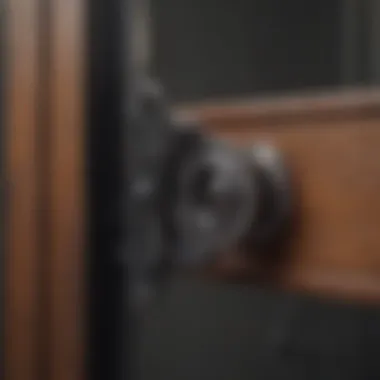
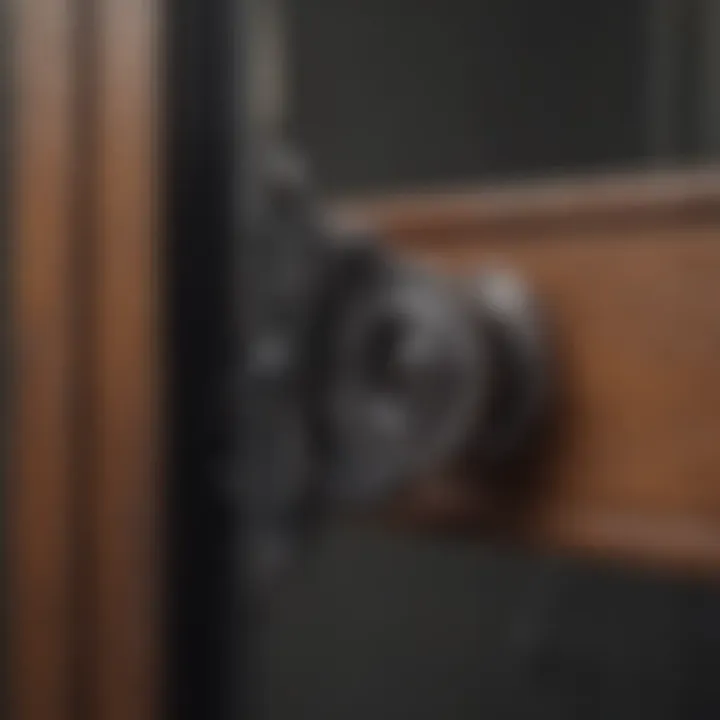
Here are key takeaways:
- Space Saving: Perfect for tight spots where swing clearance is limited.
- Flexibility: They can accommodate multiple panels in a single setup.
- Versatile Application: Often used in closets, room dividers, or laundry areas.
However, bi-pass hinges may not provide the same level of insulation as traditional or pivot hinges. Thus, if external noise or thermal insulation are concerns, it’s worth weighing your options carefully.
Choosing the right hinge type is paramount, as each offers specific advantages and potential limitations. Evaluate your needs and how each option aligns with your vision for your bifold doors.
Mechanics of Bifold Door Hinges
Understanding the mechanics of bifold door hinges is crucial for anyone looking to maximize both functionality and aesthetics in their space. Hinges are the unsung heroes of bifold doors, facilitating a smooth opening and closing motion that can significantly enhance the user experience. A well-engineered hinge not only ensures that the door operates seamlessly but also impacts the longevity and effectiveness of the door system itself.
How Hinges Facilitate Movement
Hinges are designed with specific movement in mind. The primary function of a hinge is to create a pivot point that allows the door panels to swing open and closed without dragging or sticking. This is especially important in bifold doors, where two or more panels are connected. A properly selected hinge permits a wide range of motion while keeping the panels aligned. The geometry of the hinge plays a significant role;
- Ratchet Mechanism: Some modern hinges use a ratchet mechanism to hold the door in place at various angles. This feature can come in handy for doors that need to remain open for ventilation or ease of access.
- Spring-Loaded Hinges: These hinges automatically pull the door closed, enhancing security and energy efficiency.
When evaluating how hinges help facilitate movement, it’s essential to consider the specific design and application of the bifold door, ensuring they meet the intended purpose with precision.
Load-Bearing Capacities of Hinges
Every hinge has a load capacity which is the maximum weight it can support while still functioning effectively. For bifold doors, this is particularly vital. The total weight of door panels can vary significantly based on materials used; wooden doors, for instance, can be much heavier than those made of aluminum or vinyl.
- Material Choice: A heavier bifold door will require robust hinges. Metal hinges like steel or brass usually provide the necessary strength and durability.
- Spacing of Hinges: The number of hinges also affects load distribution. More hinges evenly distribute the weight and reduce the chance of sagging over time. It’s recommended to use at least two to three hinges per panel depending on size and weight.
Durability and Material Considerations
When selecting hinges, understanding the durability based on its material composition is imperative. Choosing the right material can determine not just the life span of the hinge but also how well it will perform over time.
Metal vs. Plastic Hinges
In the battle of metal versus plastic hinges, each has its own merits. Metal hinges are generally regarded as stronger, holding heavier weights and providing better longevity.
- Metal Hinges: They deliver strength and durability, often preferred for permanent installations. Metal hinges have better resistance to wear and are less likely to break under pressure.
- Plastic Hinges: These can be lighter and potentially less expensive, making them suitable for lighter doors or temporary setups. However, they can warp or break under heavy loads.
The decision between metal and plastic hinges often comes down to the specific requirements of the bifold door system being employed.
Corrosion Resistance
A hinge's susceptibility to corrosion can’t be ignored, especially in humid or coastal environments. Hinges that corrode can lead to doors sticking or malfunctioning, which is something no homeowner wants to deal with.
- Importance of Corrosion-Resistant Materials: Stainless steel and specially coated metals are often chosen for their resistance to rust and deterioration.
- Property Benefits: Corrosion-resistant hinges offer a longer lifespan and reduce the need for frequent replacements.
In summary, understanding the mechanics behind bifold door hinges sheds light on their critical role in ensuring smooth operation and durability. With proper care and selection based on weight capacities, materials, and environmental factors, homeowners can enjoy the full benefits of their bifold doors for years to come.
"Choosing the right hinge is just as important as the door itself. It’s what keeps everything functioning just right."
This deeper appreciation of hinge mechanisms not only enhances practical knowledge but also aids in making informed decisions, be it for renovations or new installations.
Choosing the Right Hinge for Your Bifold Door
Selecting the appropriate hinge for bifold doors is not merely an afterthought. It is as critical as choosing the door style itself. The right hinge ensures smooth operation and can significantly impact the lifespan of the door system. It is essential to match the hinge's specifications with your door's characteristics and the environment where it will be installed.
Key benefits of a careful hinge selection include enhanced functionality, increased durability, and improved visual appeal. Thus, taking time to sift through options is a worthwhile investment. Understanding various elements will make the decision much clearer, paving the way for a seamless door experience.
Factors Influencing Hinge Selection
Door Weight and Size
One cannot overlook the influence of door weight and size on hinge selection. This characteristic dictates the hinge's strength and type, which is fundamental in maintaining door integrity. A heavier door will place more strain on the hinges, necessitating robust models that can handle these demands. Choosing the right hinge contributes not only to seamless operation but also to extended longevity.
Broadly speaking, larger bifold doors often require heavy-duty hinges, crafted from sturdy materials like steel or solid brass. These materials can withstand wear and tear over time. On the flip side, lighter doors can utilize standard weight hinges which are sufficient for their needs. An important note to remember is that mismatched weight and hinge type can lead to frustrating operational failures or even damage.
Usage Frequency
The frequency with which a bifold door is used plays a significant role in determining the most suitable hinge. In high-traffic areas, durable hinges are essential. Such environments demand hinges that are designed for heavy use, providing smooth operation without excessive wear.


For instance, a hinged door in a busy kitchen opens and closes multiple times a day, thereby affecting its performance requirements. On the other hand, a seldom-used closet door may not require as robust a hinge. An important aspect to consider here is that some hinges come with features that support frequent use, such as self-closing mechanisms or additional reinforcement.
Aesthetic Considerations
Aesthetic factors are simply as important when choosing hinges for bifold doors. The hinge's appearance must harmonize with the overall design of the door and the surrounding decor. Available in various finishes like satin nickel, antique bronze, or polished chrome, a well-chosen hinge can elevate the space significantly. Visual harmony contributes to cohesive interior design, making careful selection necessary.
In addition, hinges can also come in different styles which can add character to the door itself. For example, decorative hinges might add a historical touch to traditional designs, whereas minimalistic hinges suit modern decors more effectively.
Ultimately, choosing the right hinge for your bifold door is a balancing act between functionality and aesthetics. Identifying key elements such as weight, usage frequency, and design ensures that the door not only operates effectively but also looks great in the process.
"The best hinge for your bifold door is one that feels just right—functionally and visually."
By considering these aspects, homeowners can make an informed decision that amplifies their door's performance and beauty.
Installation Process
The installation process is a critical aspect of working with bifold doors, as it directly influences their performance and longevity. Proper installation ensures that the doors operate smoothly, providing the desired aesthetic and functional benefits. One of the key considerations during installation is the alignment of hinges, which if misaligned, can result in doors that stick or do not open and close properly. Being meticulous during installation can save time and future repairs, ultimately leading to a more satisfying outcome.
Preparing for Installation
Tools Required
Having the right tools is the backbone of a successful installation. A basic toolkit should include:
- Drill: Essential for making precise holes in the right spots.
- Screwdriver: Varieties such as Phillips and flathead are necessary for different screw types.
- Measuring tape: Helps ensure every measurement is accurate, especially for hinge placement.
- Level: Vital for checking that your bifold doors are aligned correctly.
The quality of these tools can make a significant difference. For instance, a sturdy drill makes it easier to manage screws without stripping them, which could lead to an unstable installation. Additionally, good measuring tape with clear markings helps avoid mistakes right from the start, making it a beneficial choice. If you skimp on tools, you might find yourself fighting against inadequate equipment, causing unnecessary delays.
Measuring and Marking
Getting the measurements right is fundamental before you even think about turning a screw. Proper measuring and marking helps ensure that the gaps between the doors are even, and that hinges are aligned correctly for optimal function. Use the measuring tape to mark hinge locations on both the door frame and the door itself. The precision of your marks could mean the difference between a professional finish and a haphazard installation.
One unique feature here is the use of a square—it's invaluable for ensuring corners are precisely at 90 degrees. A good square will help you prevent future problems such as misaligned doors or uneven gaps. Even slight miscalculations can affect how well your doors open and close, potentially leading to wear and tear over time.
Step-by-Step Installation Guide
- Prepare the Doors: Ensure that the bifold doors are ready to be hung. Check that all hardware is included, and lay out the hinges and screws for easy access.
- Locate and Mark Hinge Positions: Measure the distances for the hinges carefully and mark them up on both the frame and the doors.
- Drill Holes: Using your drill, create holes at the marked positions, ensuring that they are straight and of appropriate depth for the screws.
- Attach Hinges to Doors: Align the hinges on the doors and fasten the screws securely, ensuring that each hinge is flush with the door surface.
- Mount Doors to Frame: Carefully align the doors with the previously marked hinge locations on the frame. Securely attach hinges to the frame using the same method as before.
- Check Alignment and Test Operation: Once the doors are installed, check their alignment with a level and test the operation of the doors. They should open and close smoothly without any sticking.
With these steps, the installation of bifold doors should proceed without a hitch. Taking the time to prepare and accurately install will reward you with a functional and aesthetically pleasing product.
Maintenance and Care
The longevity and smooth functionality of bifold doors, which can be a stunning design element in both residential and commercial spaces, heavily rely on diligent maintenance and care. Just like a well-tended garden, these doors need attention from time to time. Understanding the subtleties of hinge maintenance is crucial not only for the preservation of these doors but also for ensuring optimal performance. Ignoring this vital aspect can lead to operational issues, and worse, unsightly wear that detracts from your interior design.
One key benefit of regular maintenance is that it helps to prevent minor issues from escalating into substantial, costly repairs. Conversely, neglect can result in bending or wearing out the hinges, which can lead to misalignment and complications in the door’s operation. In apartments or homes where bifold doors are frequently used, this aspect becomes even more critical. They undergo strain every time they open, close, or fold, which can lead to wear and tear over time.
Regular Maintenance Practices
Maintaining your bifold door hinges doesn't have to be a daunting task. A few straightforward practices can go a long way in extending their life.
- Lubrication: Regularly applying a lubricant to the hinges can greatly reduce friction and wear. Choose a silicone or lithium-based lubricant, as these are effective in keeping the mechanisms running smoothly.
- Cleaning: Dust and debris can accumulate around the hinges over time. Wiping them down with a damp cloth helps keep them clean and allows for a clear view of any potential issues.
- Tightening Screws: Hinges can loosen as doors move. It’s a good idea to check the screws for tightness every few months and to tighten them as needed – you don’t want them getting wobbly!
- Visual Inspections: Get into the habit of regularly inspecting your hinges for any signs of wear or damage. Keeping an eye out for corrosion or misalignment could save you from bigger headaches down the road.
Incorporating these practices into your home maintenance routine can enhance the lifespan of your bifold doors.
Signs of Wear and When to Replace
Despite your best efforts, wear and tear can occur, and it's critical to recognize when replacement is the best option.
Some common signs of wear include:
- Rust or Corrosion: If you spot rust forming on metal hinges or visible corrosion on the surface, consider replacements rather than just cleaning. Rust weakens the hinge and can lead to failure.
- Wobbling or Loose Movement: If your door feels unsteady or the hinges are wobbling during operation, it could indicate that the hinge mechanism is failing.
- Squeaking Noises: If you hear persistent squeaking no matter how much lubrication is applied, it might be time to replace those hinges. It suggests that internal parts are worn out.
- Difficulty in Operation: If the door no longer opens or closes smoothly, or if it requires excessive force, that might mean the hinges are no longer fit for purpose.
Remember: Spotting these signs early can save you from extensive repairs later. If you're unsure about the condition of your hinges, consulting a professional can provide peace of mind.
In general, replacing bifold door hinges every few years is advisable, particularly in high-traffic areas. Keeping a proactive approach towards maintenance will not only ensure the functionality of your doors but also their aesthetic appeal, making them a reliable choice in your space.
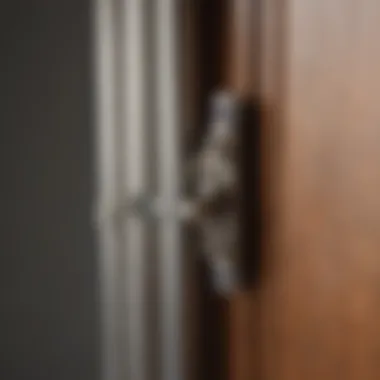

Bifold Doors in Commercial and Residential Settings
Bifold doors have gained significant traction in both commercial and residential spaces, transforming the way we interact with our environments. With their ability to seamlessly connect indoor and outdoor areas, they're not just about aesthetics; they also offer practical benefits. In this section, we'll dissect the importance of bifold doors, highlighting their versatility, functionality, and the considerations that come into play when integrating them into different settings.
Applications in Residential Design
In residential design, bifold doors shine as a beacon of modern convenience and style. Homeowners often seek ways to merge their livable spaces with the great outdoors, allowing natural light to pour in while maintaining a flow that feels both open and inviting. Here are a few points illustrating why bifold doors have become a favorite:
- Space Optimization: Bifold doors can fold back completely, opening up entire walls. This feature is particularly advantageous in homes where space is at a premium, allowing for more flexible utilization of the area.
- Enhanced Natural Light: With large glass panels, these doors flood living areas with daylight, reducing the need for artificial lighting during the day. Enhanced natural light not only uplifts the mood but also gives spaces a more spacious feel.
- Aesthetic Appeal: Available in various materials and finishes, bifold doors contribute to a home's charm and modernity. They serve as statement pieces that invite admiration while blending beautifully with various architectural styles.
When considering bifold doors for residential spaces, factors such as alignment with existing decor, security features, and energy efficiency should be evaluated.
Commercial Usage Scenarios
In commercial settings, the application of bifold doors is equally impressive. They cater to numerous needs, from enhancing traffic flow in bustling retail environments to creating inviting entrances in eateries. Let’s explore some common applications:
- Retail Spaces: Using bifold doors in shops allows for a wide entryway that can be fully opened during peak hours. This not only increases visibility from the street but also creates an immersive shopping experience for customers.
- Cafes and Restaurants: Many dining establishments opt for bifold doors to create an al fresco dining experience. In good weather, the doors can be opened fully to merge indoor and outdoor seating, attracting patrons and promoting a lively atmosphere.
- Office Environments: In commercial offices, bifold doors can be used to create flexible meeting spaces. They allow for quick transitions between larger areas for gatherings and smaller spaces for focused work.
Both settings underscore the adaptability of bifold doors and their capability to enhance user experience. Security, durability, and design coherence remain crucial elements to ensure these doors not only serve their purpose effectively but also align with broader safety regulations and space functionality.
"Bifold doors represent an intersection of beauty and utility, where form meets function in both residential and commercial applications."
Thus, as we delve deeper into the dynamics of bifold doors, it becomes clear that their role extends far beyond mere entry points. They embody a modern solution to space management and environmental integration that homeowners and business owners alike have come to value.
Innovation in Hinge Design
Bifold doors have gained popularity due to their ability to optimize space and enhance aesthetic appeal. However, the core of their functionality relies heavily on the hinges that allow them to fold and slide seamlessly. Innovations in hinge design are revolutionary in this field, and understanding them can lead to smarter choices for homeowners and builders alike.
With technology evolving rapidly, hinge design is no longer just about basic functionality. Manufacturers now integrate high-performance materials and unique engineering solutions to improve efficiency and longevity of hinges. Families today want products that offer both beauty and reliability.
Advancements in Material Technology
When it comes to hinge design, material choice plays a pivotal role. The shift from traditional metals to advanced options has made a significant impact. For instance, lightweight yet durable composites are gaining traction. These materials are not only resistant to corrosion but also provide enhanced strength-to-weight ratios. Homeowners facing humid or moisture-prone environments find that using materials like stainless steel or specialized alloys can deter rust and other forms of degradation.
Moreover, coatings applied to hinges can render them not only more resilient but also visually appealing. A homeowner may choose a matte finish as a stylish update, while also ensuring that they are investing in longevity.
Consider these factors when evaluating hinge materials:
- Weight: Heavier hinges can carry larger doors but might strain the frame over time.
- Corrosion Resistance: Essential for areas with high humidity.
- Aesthetic Compatibility: Finishes that blend well with the overall design of the bifold doors.
Smart Hinges and Automation
The advent of smart technology is revolutionizing hinge design, making it an exciting time for bifold door users. Smart hinges incorporate electronic features that can enhance the door's functionality. Imagine a bifold door that can be opened with a simple voice command or a touch from your smartphone!
Such innovations hold a variety of benefits:
- Increased Control: Homeowners can manage doors remotely, offering added convenience and security.
- Energy Efficiency: Smart hinges can be programmed to close at specific times to conserve energy, especially in homes with heating and cooling considerations.
- Adaptable Designs: Many smart hinge systems can be tailored to fit specific needs, making them perfect for custom bifold door applications.
To put it simply: integration of smart technology into hinge systems is not merely a trend but a forward-thinking approach to home living that appeals to tech-savvy house owners.
"Innovations in hinge design reflect a broader trend in architecture and design where functionality meets technology and aesthetics."
In summary, keeping up with hinge innovations can significantly enhance both the usability and the longevity of bifold doors. As the market expands, products that blend advanced materials with intelligent technology will only become more prevalent, providing even more options for homeowners to explore.
Culmination
The conclusion of this article integrates a wide array of considerations regarding hinges for bifold doors, which are often overlooked yet crucial in both residential and commercial spaces. Recognizing the specific attributes of hinges and how they contribute to the overall function of bifold doors is essential. These mechanisms serve as the backbone that ensures smooth operation, maximizes space efficiency, and contributes to aesthetic appeal.
A well-chosen hinge can considerably influence how these doors perform, making it imperative to consider the weight and size of the door, the frequency of use, and even stylistic choices that harmonize with the surrounding decor. Understanding the nuances of various hinge types—from traditional ones that have stood the test of time to the latest advancements in smart technology—opens up opportunities for customization.
"The right hinge not only enhances functionality but also speaks to the design sensibilities of a space."
Additionally, feedback from users highlights the substantial role regular maintenance plays in prolonging the life of both the hinges and the doors they support. Awareness of wear and the availability of replacement parts forms an integral aspect of proper care that should not be neglected. As we look ahead, trends in hinge technology are evolving, promising innovations that could further revolutionize the way bifold doors are integrated into modern architecture.
Summary of Key Points
- Hinge Function: Hinges are critical components that enable smooth movement and stability in bifold doors.
- Types of Hinges: Various hinge designs, including traditional, pivot, concealed, and bi-pass, cater to different needs and aesthetics.
- Selection Criteria: Factors such as door weight, size, and frequency of use significantly influence the right choice of hinge.
- Installation and Maintenance: Proper installation methods and ongoing care are essential for optimal performance and longevity.
- Applications: Bifold doors find versatile applications in both residential and commercial settings, enhancing convenience and style.
- Innovations: The advent of smart hinges and advanced materials paves the way for enhanced functionality and durability.
Future Trends in Hinge Technology
The future of hinge technology looks promising with advancements that reflect changes in lifestyle and design preferences. Here are some anticipated trends:
- Smart Automation: Expect hinges integrated with sensors to allow for automated opening and closing mechanisms, possibly even via smartphone apps.
- Sustainable Materials: With growing environmental concerns, hinges made from eco-friendly materials will gain popularity, providing durability without compromising sustainability.
- Customization Options: Increasing demand for personalization in home design may lead to more customizable hinge solutions, from finish to size.







